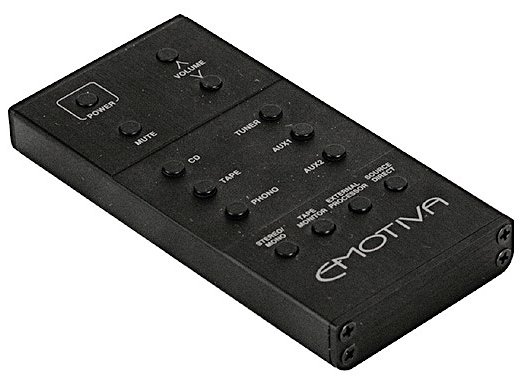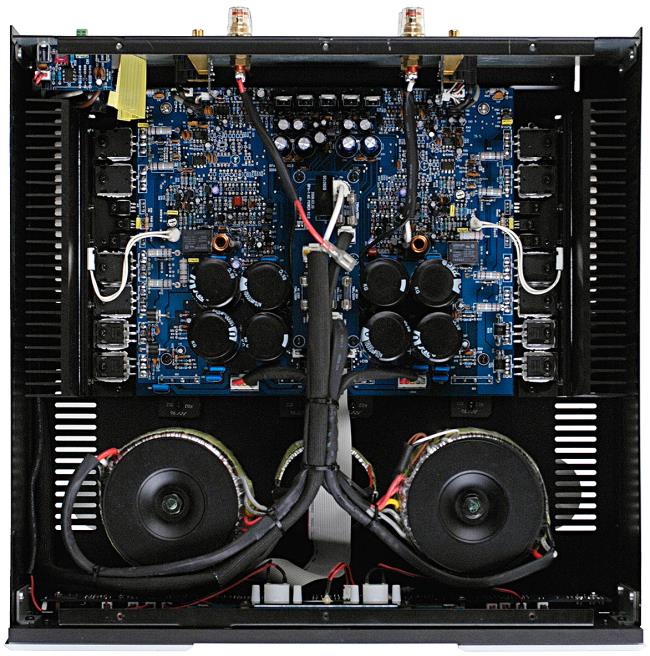The subwoofer output is via a
mono RCA or XLR. I personall y
have no use for such a feature, but some might find it useful. It is fully
bypassable, giving you two full range RCA or XLR outputs when not in use,
but does cause the signal to have to go though one more switch.
y
have no use for such a feature, but some might find it useful. It is fully
bypassable, giving you two full range RCA or XLR outputs when not in use,
but does cause the signal to have to go though one more switch.
Connectors for IR inputs and
outputs are available for integration with home theater automation products,
and a 12V trigger output is present, with a cable provided for use with the
RPA-1 amplifier. This very nice feature allows the amplifier and
preamplifier to turn on and off together.
One feature I am a big fan of is the phono preamp. The RSP-1 comes with a
built in MM/MC phono preamp with gain that is selected by a rear panel
toggle switch.
I used the processor loop to
integrate the RSP-1 and RPA-1 into my home theater. I used the loop input to
connect my Rotel surround sound processor, and engaged it using the
processor loop button on the remote and front panel. Unfortunately for this
application, the volume control is downstream from the processor loop, so I
had to find a "unity gain" volume knob setting to use with the SSP. I used
an SPL meter to match the level of the RSP-1/RPA-1 to the center channel
driven directly by the SSP, and then made a small pencil mark on the front
panel to note the volume setting. It would be nice if the volume control
were upstream of the processor loop, with only unity gain buffering after
the loop. This would allow easier SSP integration without affecting the use
of other processors like equalizers or external crossovers.
The RPA-1 is a dual-mono design, with two
independent toroidal power transformers and 144,000 μF
of power supply capacitance (comparable with the capacitance in many ultra
high-end and ultra high-dollar power amps). Inputs are high quality chassis
mounted RCA connectors for the single ended inputs, and XLRs for the
balanced inputs. Dual, high quality five-way binding posts allow bi-wiring.
The clear plastic nuts allow the connections to be properly finger tightened
with no wrench, and can accept virtually any speaker cable.
A nice, albeit unnecessary "toy" are a pair of
blue illuminated VU meters on the front panel. Turn-on can be via a signal
sensing circuit, a 12V trigger or the front panel switch. The amplifier is
presumably biased into class A/B operation, but it warms up extremely
quickly, and dissipates 46W while idling.
I used the 12V trigger signal from the RSP-1
for most of my auditioning. Quality of assembly on the circuit board is
first rate, and high quality parts are used throughout, including 1%
tolerance resistors, and thick circuit traces with lots of ground plane
covering unused board real estate.



Given the Emotiva goal of providing high
quality at a low cost, I personally could have done without the VU meters on
the amplifier. Maybe that could have freed up enough money to have two
completely separate circuit boards for the right and left channels. On the
RSP-1, the bass management feature is not something really needed for
two-channel audio, even for those of us who use subwoofers.
The same goes for the tone controls. Maybe
this effort could have been invested in a separate power supply board with
discrete regulation. If the RSP-1 and RPA-1 did not deliver in the sound
department, maybe these would be valid complaints, but I have no complaints
at all about the sound quality. In fact . . .
Click Here to Go to Part III.